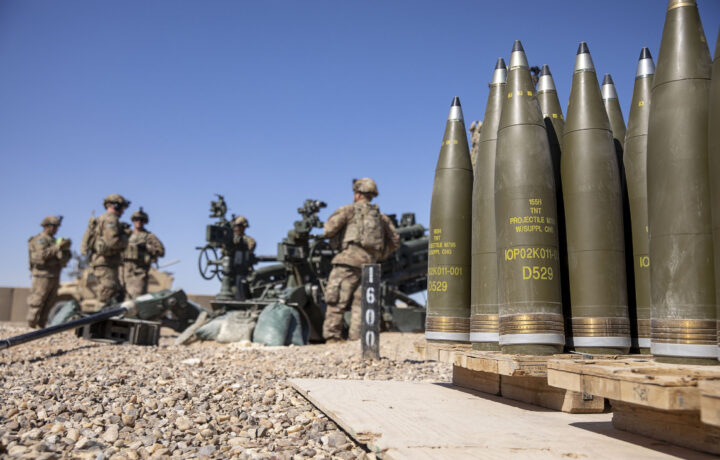This month will mark the two year anniversary of the war in Ukraine – which Moscow still describes as a “special military operation.” Last year’s highly anticipated offensive by Kyiv’s forces failed to deliver the expected victory that some predicted. Instead, the conflict has continued to be one of static lines that in parts of the country resemble the hellscape of the Western Front during the First World War.
Another similarity to the conflict fought more than a century ago is the fact that the ongoing war in Ukraine has become one of artillery slug matches. That has taken its toll not only on the soldiers on the frontlines but also on U.S. military supplies of ordnance. As reported last summer, while the U.S. military watched some of its stockpiles dwindle to dangerously low levels. That included the 155mm artillery rounds, which are employed in the M777 Howitzer.
Ramping Up Munitions Production
Replenishing efforts have been under way, and the U.S. Army has set a goal of producing 100,000 155 mm shells per month by 2025. Earlier this week, Doug Bush, the assistant secretary of the Army for acquisition, logistics and technology, said the service is already “on a path” towards producing 70,000 to 80,000 shells per month by the end of calendar year 2024 or early 2025.
The increased production will allow the United States to restock its arsenals as well as those of its allies, who have also recognized the need for “a deeper well of munitions on the shelf” but also more production capacity, Bush added an event hosted by the Center for Strategic and International Studies on Monday.
Robotic Assembly Lines
Bush explained that to maximize its production capacity, the U.S. Army has been investing in new manufacturing technologies, and that includes automation and robots.
“If you could maintain a factory of robotics that don’t need as many people and the robots could be maintained at a relatively lower cost, there is your surge capacity, as long as they’re maintained,” Bush suggested. “And also you get better quality [munitions] and they don’t take breaks. There are many advantages to just using modern manufacturing techniques.”
Robots have been seen as offering several key advantages in military munitions production, notably in being far more scalable than human workers. Robotic systems provide added flexibility, as robotic arms can perform multiple tasks using a smaller factory footprint, while a manufacturing system employing a modular design can be duplicated, expanding a manufacturer’s capacity as demand increases.
In addition, robots can provide an automated inspection to improve quality control, and monitoring a facility for any signs of danger to ensure that human workers remain safe.
The Army has seen these advantages, and has invested around half a billion dollars at its artillery plant in Texas. At the same time, Bush has said that modernization also doesn’t equate to fewer jobs – rather it will mean “different jobs,” which could require “upskilling” the workforce.
“I don’t see it as a great downsizing,” Bush further explained. “I see it just as a shift in what people do day to day.”
Explosive Problem
Although robots can help with the production, there are still other issues that will need to be overcome. Chief among them is one of explosives.
“You have to produce enough explosives – either IMX-104 or TNT – to fill that many shells that fast and that production capacity does not exist in the United States by itself,” Bush also explained. “We’re having to go overseas to allies.”
According to a report from Defense News, each 155mm shell contains 22 pounds of explosives – and if the U.S. is able to ramp up to the required 100,000 rounds per month, it will require 26.4 million pounds of explosives.
Last fall, the U.S. Army awarded $1.5 billion in contracts to nine companies in the fall of 2023 to companies in the U.S., Canada, India and Poland to boost global production of 155mm artillery rounds. The contracts included procuring 14.2 million pounds of bulk energetics, consisting of TNT and IMX-104 explosive.
The U.S. could nearly triple the amount of IMX-104 that is produced at the Holsten Army Ammunition Plant in Tennessee. That facility produces roughly five million pounds a year, while a planned $600 million investment would increase it 13 million pounds. That is in addition to a proposed $93 million to upgrade facilities to reestablish M6 propellant production at Radford Army Ammunition Plant in southwest Virginia.
Radford Army Ammunition Plant
The Radford Army Ammunition Plant could also receive $650 million to restart the production of domestic TNT. Currently there is no TNT production in the U.S. and its supplies come from allies including Australia and India. Poland is a major supplier, and while the U.S. Army signed a contract with the Polish Nitro-Chem chemical plant last October, Poland is also struggling to meet its own demands.
Major manufacturing of TNT began in the United States in 1916 during the World War I, and it was produced in enormous quantities both commercially and at government ammunition plants during both World Wars.
Last fall, the U.S. Army issued a request for information on Sam.gov for the design, construction and commissioning of a facility capable of producing five million pounds of TNT per year. Responses from industry are due February 17.




